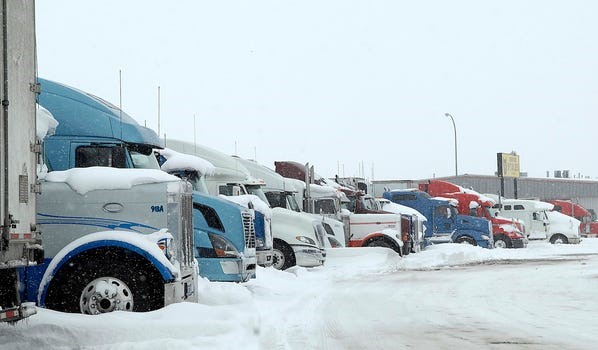Every winter it seems like CMV drivers have to re-learn how to drive safely after they encounter the first snow storm of the season. Interstate-80 across Wyoming is one of the worst stretches of highway for major truck wrecks in the lower 48. In my many years of driving I-80, I have encountered rain, hail, snow, ice, black ice, and a truck crash, all within a 50 mile stretch of the interstate.

CMVs Parked In Snow
WYDOT (Wyoming Department of Transportation), and many other states, have installed variable speed limits and overhead signage that can really help drivers to understand road conditions. All drivers can use this system and follow these winter driving tips to help prevent major pileups and fatal crashes that occur every winter.
1. Trucks are big, and take a lot more concentration to operate safely, so slow down in ANY winter driving condition. Don't forget federal regulation: §392.14 Hazardous Conditions; Extreme Caution. Slow your speed to safely control your truck or find a safe place to park until conditions improve. This is not a suggestion! It is a federal regulation. Slowing down and keeping a steady pace will get you to your destination safely and most of the time, sooner.
2. In the winter, it is especially important to establish a safe zone around your truck. Trucks occupy a large space and need a lot of room for a buffer zone around them. You can't control other drivers on the road, but if you leave yourself plenty of space to your sides and front, the chances of being involved in a crash will be greatly reduced. Remember the 12-15 second rule from your CDL Manual. Leave 12-15 seconds between you and the truck in front of you, giving you adequate time to react in, with the proper response in an emergency situation. Leave even more space if the road conditions are worsening.
3. Avoid traveling in a group or convoy going down the interstate. Driving in packs seems to be normal, but you are safer if you separate yourself from groups of trucks. In winter driving, the pack is not safe, because it’s too easy for a chain reaction crash to happen. Keep a safe distance behind others. The use of a CB Radio (when used safely) for learning what's going on ahead of you is a great way to communicate. Many times, the oncoming truckers will advise you of conditions ahead. This is one way to avoid the need of a convoy.
4. Plan your route carefully every day using your GPS on your phone and/or communicating with dispatch. Both can inform you on what the weather is doing 200 miles ahead of you. The phones of today are small computers in your hands and can do many things from receiving weather alerts to checking traffic conditions ahead. Be sure to use your phone only when you are stopped. Many drivers today get fixated on their phones while driving, which may be a contributing factor to many fatal CMV accidents.
5. Winter driving conditions are unpredictable and unforgiving. A change in weather can lead to bad road conditions in a hurry. On rests and stops, be sure to review weather conditions for the remainder of the route. Being well rested and alert to changing conditions can save your life as well as the lives of others.
6. Be smart and use common sense to make the right decision. If you don't feel comfortable driving in the conditions, stop and wait the storm out at a safe place. Most of the time if you lose your confidence, things go wrong. The weather or anything out of the ordinary that seems “off” is a good warning to shut it down. It is much safer to sit it out than try to drive when your instincts tell you different.
7. Avoid stopping on the shoulder of the road in low visibility. If conditions are very bad, then stopping your rig on the shoulder of an interstate can really lead to a major collision. Planning, common sense, communicating with others and dispatch, and looking far enough ahead will help prevent you from having to stop on the shoulder. When conditions worsen, start looking for an exit to get safely off the road. If you must stop for emergency reasons, pull off as far as you can. Getting stuck in a snow drift 20 feet off the shoulder is much safer than getting impacted from the rear.
8. Delays happen every day in the trucking world. No load is as important as a human life. Dispatchers are not in the driver’s seat; you are the captain of your ship. Don't let anyone convince you to keep traveling when you don't feel it's safe. Wait and be late, or you could face a serious collision. It can be a simple choice.
9. Jake Brakes on icy roads can lead to losing control of your rig in a hurry. A good rule of thumb is if conditions are bad enough to slow your speed down, it's time to turn off your Jake Brake. Using a light amount of brake pressure and looking far enough ahead will get you safely slowed down. Your Jake Brake can cause you to lose control and cause your rig to break loose and jackknife way too easy on ice and in snow conditions.
10. Do a thorough pre-trip inspection before heading out in bad weather. Many drivers hurry through a pre-trip inspection because it's too cold or snowy and this is the time you need to take twice the time looking over your rig. Ensuring that all brakes are properly adjusted means crawling under your truck and trailer in foul weather, but this will give you the assurance of a straight and complete stop in an emergency situation. Check your lights and leave them on during the day. Check your wiper fluid and wipers. Check your tire pressure. All these things will help you get down the road safer in winter conditions.
11. Be sure your fuel tanks are full before heading out in bad weather. No one can predict what will transpire in the day of driving. You may be stuck in traffic from a road closure or a collision for hours, even days. Topping off your fuel tanks and adding a fuel conditioner will keep your engine running if an emergency arises.
These safety tips for truckers are to help everyone on the road. We all need to make it home, wherever home is. Be smart, be safe. Travel safely.
